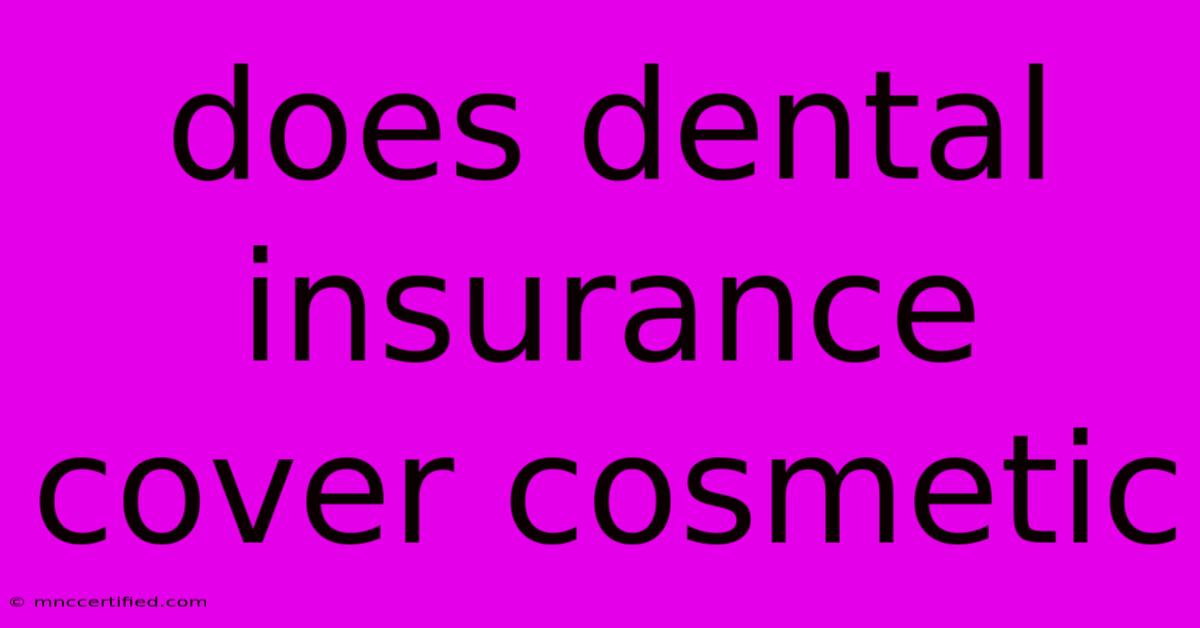Does Dental Insurance Cover Cosmetic

Table of Contents
Does Dental Insurance Cover Cosmetic Procedures? A Comprehensive Guide
Are you considering a smile makeover? Perhaps you're dreaming of a whiter smile, straighter teeth, or closing gaps between your teeth. But before you dive into the world of cosmetic dentistry, a crucial question arises: does dental insurance cover cosmetic procedures?
The answer, unfortunately, is often no. While dental insurance typically covers necessary dental care like fillings, cleanings, and extractions, cosmetic procedures are generally considered elective and fall outside the scope of most insurance plans.
Why Cosmetic Procedures Aren't Typically Covered
Here's why your insurance might not cover your dream smile:
- Elective Nature: Cosmetic dentistry is designed to enhance the appearance of your teeth, not to address medical issues. Insurance companies prioritize treatments that improve oral health and prevent future problems.
- Cost Considerations: Cosmetic procedures can be expensive, and insurance companies aim to keep premiums affordable. Covering elective treatments would likely increase premiums for all policyholders.
- Definition of "Cosmetic": The distinction between necessary and cosmetic procedures can be subjective. Some treatments, like bonding or veneers, might have both functional and aesthetic benefits. However, insurance companies often categorize these as purely cosmetic.
What Does Dental Insurance Typically Cover?
To avoid confusion, here's a quick breakdown of what most dental insurance plans typically cover:
- Preventive Care: Regular cleanings, checkups, and fluoride treatments.
- Basic Restorative Care: Fillings, root canals, crowns, and extractions.
- Major Restorative Care: Dentures, bridges, and implants (often with limitations and waiting periods).
Exceptions to the Rule: When Cosmetic Procedures Might Be Covered
While it's rare, there are some scenarios where insurance might contribute to cosmetic procedures:
- Medical Necessity: If a cosmetic procedure addresses a medical condition like a misaligned jaw or a chipped tooth caused by trauma, it might be deemed medically necessary and covered by insurance.
- Specific Coverage: Some insurance plans might include limited coverage for certain cosmetic procedures, such as teeth whitening or Invisalign. It's essential to check your policy details carefully.
- Dental Health Savings Accounts (HSAs): If you have a dental HSA, you can often use funds to pay for cosmetic procedures, as long as they are deemed medically necessary.
Tips for Paying for Cosmetic Dentistry
If your insurance doesn't cover your desired procedure, don't despair! There are still options to make your dream smile a reality:
- Savings Plan: Set aside a dedicated amount each month to save for your cosmetic procedure.
- Payment Plans: Many dental practices offer payment plans to help you manage costs.
- Financing Options: Consider using a personal loan or a credit card with a low interest rate.
- Comparison Shopping: Get quotes from multiple dentists and explore different financing options to find the best deal.
Final Thoughts
Understanding the limitations of dental insurance when it comes to cosmetic procedures is crucial. While insurance rarely covers purely aesthetic treatments, there are exceptions and strategies to make cosmetic dentistry more affordable. Be sure to research your options thoroughly, compare costs, and communicate openly with your dentist to create a customized plan that fits your budget and desired outcome.

Thank you for visiting our website wich cover about Does Dental Insurance Cover Cosmetic. We hope the information provided has been useful to you. Feel free to contact us if you have any questions or need further assistance. See you next time and dont miss to bookmark.
Featured Posts
-
La Liga Real Sociedad Edges Barcelona 1 0
Nov 11, 2024
-
Can Carvalhal Lead Braga Past Sporting
Nov 11, 2024
-
Bonding Bushing Vs Grounding Bushing
Nov 11, 2024
-
How Do You Value An Insurance Agency
Nov 11, 2024
-
Edmund Fitzgerald The Shipwreck That Shocked The World
Nov 11, 2024